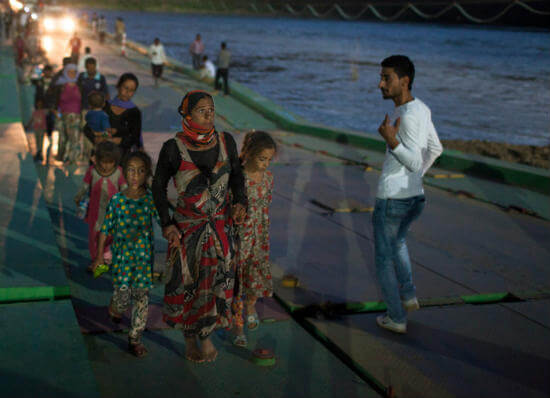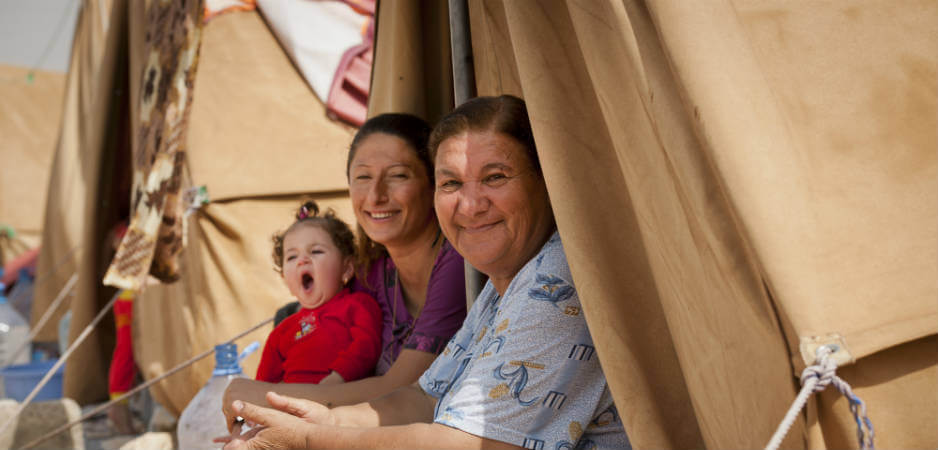When it comes to peacebuilding, women are often relegated to more traditional gender roles while their untapped capacity to wage peace is left ignored.
In discussions of conflict and its associated processes of resolution, women are often defined by their relationships to their male counterparts or as tokens representing the brutality of war. Women are either the sisters, mothers or daughters of both perpetrators and peacemakers, or they are mere poster children of victims caught up in battles over power, land and ideology.
When we think of war and armed conflict, we envision traditionally masculine traits such as aggression, power and strength. So why is it that we do not envision opposing traits such as trust, cooperation and fairness when seeking peace? As seen worldwide, when it comes to peacebuilding women are often relegated to more traditional notions of gender roles while their largely untapped capacity to wage peace is left ignored.
Before discussing exactly how to challenge these notions and to incorporate female actors into peacebuilding processes, we must first ask if women do in fact contribute to greater peace and stability. According to a number of research studies, women’s participation and equality are both contributing factors to successful conflict resolution efforts and strong predictors of a state’s peace and stability.
A Case for Women
One study found that women’s inclusion resulted in peace agreements that were 20% more likely to last at least two years and 35% more likely to last for 15 years. As for predicting peace, research indicates that states with higher levels of gender inequality are more likely to undergo internal conflict and that gender equality indicators are stronger predictors of peace than more traditional indicators such as GDP, religion or democracy.
Currently, we see that women are drastically underrepresented in peace processes worldwide. In 2012, a UN Women examination of 31 major peace processes since 1992 found that women comprised “4 per cent of signatories, 2.4 per cent of chief mediators, 3.7 per cent of witnesses and 9 per cent of negotiators between 1992-2011.” Furthermore, another study found that from 1990 to 2010, only 16% of peace agreements worldwide contained specific references to women.
So why exactly are women being left out of peace processes across the globe? In short, sexism is both a cause and an underlying contributor to other obstacles to inclusion as women and their interests are not seen as priorities. When it comes time to sit down at the negotiating table, processes tend to focus on belligerents and their representatives who do not want to diminish their authority through the inclusion of other actors.
Furthermore, institutional constraints such as timelines and deadlines make peacebuilders wary of actor proliferation and the task of identifying legitimate and influential parties. Finally, the effects of conflict greatly differ when it comes to men and women. Research shows that while men make up the majority of those killed directly in armed combat, women suffer much more from the indirect effects of war and may in fact have a higher mortality rate due to indirect factors such as infectious disease, domestic violence, economic devastation and human rights abuses.
Due to this dichotomy in victimhood, peace negotiations often ignore continued threats against women once negative peace, or the cessation of violence, has been established.
These concerns are not entirely new to the international community and a number of efforts have been made to promote women’s participation in peacebuilding activities. Passed on October 31, 2000, United Nations Security Council Resolution 1325 is perhaps the most widely mentioned expression of support for women’s involvement in peacebuilding. It highlights the fact that in the post-Cold War era, civilians, and women especially, are more frequently the targets of violence and it outlines a number of principles for increasing women’s participation in peacebuilding and decision-making. Since 2000, 63 countries have established national action plans to support the implementation of UNSCR 1325 and mentions of women in peace agreements have increased from 11% to 27%, likely as a result.
Iraq Needs Women Peacebuilders
Iraq, which recently adopted its own National Action Plan (INAP) and was the first in the MENA region to do so, is poised to present an interesting test for such plans in reconciliation efforts leading up to and following the demise of the Islamic State (IS) within its borders. Despite increased hopes in the wake of a series of recent military victories there is growing concern about what exactly post-IS Iraq will look like.
Land disputes between the central government and the Kurdish Regional Government (KRG), the presence of and allegiance to multiple security actors, reprisal attacks and tribal conflict, difficulty in IDP returns, tensions between IDP and host communities, an ongoing economic crisis and numerous minority and ethnic conflicts provide enormous hurdles for future reconciliation and stability.
Research by Sanad for Peacebuilding found that barriers to women’s inclusion in peacebuilding processes in Iraq largely fall in line with the rest of the world. In a focus group discussion, participants emphasized lack of women’s capacity-building measures, family and social pressure to conform to traditional gender roles, pervasive use of negative stereotypes in the media and a lack of civic and human rights education programs as important contributors to women’s continued exclusion.

Displaced Yazidis enter Kurdistan, Aug. 9, 2014 © Ali Arkardy
Additional constraints, many of which are irreparable in the near future, also threaten overarching inclusion efforts. For instance, UN Iraq found that only 41.5% of Iraqi women believed that women should participate in political affairs and only 10% reported joining a clubhouse, social club, union, political party or a women’s association.
Furthermore, male biases against women’s social inclusion were further identified. United Nations Population Fund (UNFPA) found that only about half of men aged 10-30 in Iraq supported women’s right to work. Finally, Iraqi women and girls currently have much lower literacy rates in comparison to their male counterparts, and the figures are much larger in rural areas. In 2013, the illiteracy rate of women and girls aged 12 and older was 28.2%, which was more than double the male rate of 13%. The illiteracy rate of women and girls aged 15 to 24 in rural areas was 33.6%. All of these figures constitute considerable impediments to women’s capacity and social willingness to support and participate in peacebuilding processes.
While there is a vast array of boundaries affecting both women’s inclusion and peacebuilding efforts in Iraq, a number of strategies may help mitigate their effects. First, the use of actor mapping, or the identification of influential actors, may help eliminate concerns regarding interest proliferation and representativeness.
Next, relevant entities are encouraged to provide trainings to increase women’s peacebuilding capacities across numerous roles and modalities on the peacebuilding spectrum. Finally, rates of women’s participation and their effects are virtually unknown in Iraq due to lack of gender disaggregated data from the government, local and international NGOs and international entities. The collection, use and examination of such data provide opportunities to have a better understanding of both gaps and opportunities.
The use of these strategies is paramount in central institutions such as the National Reconciliation Committee in the prime minister’s office. The establishment of a monitoring framework in line with INAP, and the corporation of women in the committee’s stabilization mechanisms in areas such as Nineveh, Saladin, Anbar and Diyala will provide unique opportunities to capitalize on the crucial role that women play in society and to pave the way for women’s future inclusion both in Iraq and in other conflict areas.
Furthermore, women should play a role in the design and implementation of trust-building mechanisms given women’s vital role in communities nationwide.
The Iraqi National Action Plan has certainly provided a framework for women’s inclusion in peacebuilding mechanisms moving forward. However, a conscious and concerted effort from the central government and KRG, local and international NGOs and international agencies needs to also be put forth in order to supplement the objectives of INAP. Otherwise, women will lose crucial opportunities to not only determine their futures but the future of Iraqi society as a whole.
The views expressed in this article are the author’s own and do not necessarily reflect Fair Observer’s editorial policy.
Photo Credit: Claudiad
Support Fair Observer
We rely on your support for our independence, diversity and quality.
For more than 10 years, Fair Observer has been free, fair and independent. No billionaire owns us, no advertisers control us. We are a reader-supported nonprofit. Unlike many other publications, we keep our content free for readers regardless of where they live or whether they can afford to pay. We have no paywalls and no ads.
In the post-truth era of fake news, echo chambers and filter bubbles, we publish a plurality of perspectives from around the world. Anyone can publish with us, but everyone goes through a rigorous editorial process. So, you get fact-checked, well-reasoned content instead of noise.
We publish 2,500+ voices from 90+ countries. We also conduct education and training programs
on subjects ranging from digital media and journalism to writing and critical thinking. This
doesn’t come cheap. Servers, editors, trainers and web developers cost
money.
Please consider supporting us on a regular basis as a recurring donor or a
sustaining member.
Will you support FO’s journalism?
We rely on your support for our independence, diversity and quality.







